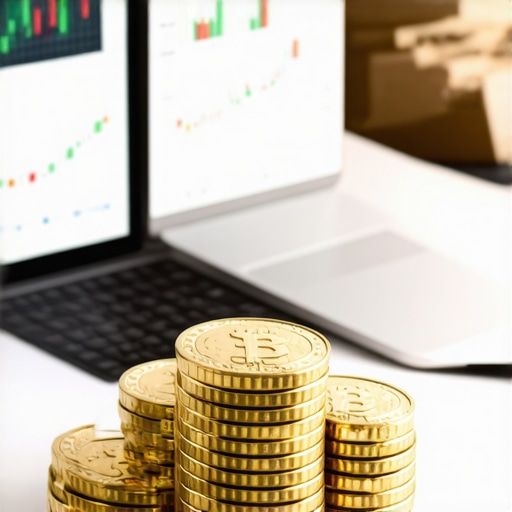Mastering Gold Investment Dynamics: A Strategic Perspective for 2025
As global economic uncertainties persist, sophisticated investors recognize gold not merely as a safe haven but as a multifaceted asset class capable of reinforcing long-term wealth preservation. In 2025, the landscape of gold investments demands a nuanced understanding of market drivers, geopolitical influences, and innovative financial instruments that can optimize portfolio resilience.
Deconstructing the Evolution of Gold Assets: From Physical Bullion to Derivative Instruments
How do emerging financial derivatives enhance gold investment portfolios?
Recent developments in gold derivatives, such as futures and options, provide traders with leverage and hedging capabilities that surpass traditional physical holdings. These instruments enable precise risk management and speculative opportunities, aligning with institutional strategies aiming for diversification and risk-adjusted returns. For example, strategic use of gold futures can capitalize on short-term volatility while safeguarding long-term positions.
Integrating Gold Mining Stocks and ETFs: A Synergistic Approach
Beyond direct gold ownership, equities in gold mining companies and gold ETFs offer exposure to the metal’s price movements with added leverage. Analyzing the operational efficiencies, geopolitical risk factors, and technological advancements within mining sectors provides an edge for discerning investors seeking to outperform pure bullion strategies.
Understanding the Impact of Central Bank Policies and Global Demand Trends
Recent shifts in central bank gold purchases, as detailed in this comprehensive report, indicate a strategic accumulation pattern that could influence market prices. Investors should monitor these policy shifts alongside emerging jewelry and technology demand sectors, which collectively shape the supply-demand equilibrium and price forecasts.
What are the Optimal Strategies for Building a Resilient Gold Portfolio?
Constructing a resilient gold portfolio involves a layered approach: combining physical gold assets, derivatives, and equities while maintaining liquidity and diversification. Long-term holdings can be balanced with tactical trades based on macroeconomic indicators, inflation trajectories, and geopolitical developments.
Engaging with expert insights: How can novice investors leverage advanced strategies without overexposure?
Beginners should prioritize education, starting with a foundational understanding of gold’s role in portfolio diversification, then gradually integrating sophisticated instruments under expert guidance. Consulting authoritative sources like the latest demand trend analyses ensures informed decision-making.
To deepen your expertise, explore our detailed analysis of top gold coins and bullion options for 2025. Embrace a data-driven approach to gold investment, leveraging advanced financial instruments and macroeconomic insights for sustained wealth accumulation.
As noted by the World Gold Council, strategic gold investments can significantly hedge against inflation and currency devaluation, provided that investors employ a diversified, well-informed approach. Staying ahead in 2025 requires continuous education and adaptation to the evolving market landscape.
Explore more about developing a long-term gold investment strategy by visiting this comprehensive guide.
Unlocking Sophisticated Gold Investment Techniques for 2025
As the global financial landscape becomes increasingly complex, savvy investors are exploring innovative strategies to maximize their gold holdings. Moving beyond traditional physical bullion, leveraging derivative instruments, and understanding geopolitical influences are essential for constructing a resilient portfolio in 2025. This comprehensive approach ensures that investors can adapt to rapid market shifts and capitalize on emerging opportunities.
How Do Market Dynamics and Derivative Instruments Interact?
Derivatives, such as options and futures, serve as powerful tools for advanced investors aiming to hedge risk or amplify returns. These instruments enable precise timing and leverage, allowing traders to respond swiftly to price fluctuations driven by macroeconomic indicators or geopolitical events. For example, strategic use of gold futures can serve as a hedge against inflation while offering speculative gains during short-term volatility. A key aspect is understanding the correlation between derivatives and physical gold prices, which can be analyzed through sophisticated models like the **Gold Price Forecasts for 2025** (see this expert analysis) that incorporate global economic indicators.
Can Gold Mining Stocks and ETFs Serve as Leverage Points?
Incorporating gold mining stocks and ETFs into a diversified portfolio offers amplified exposure to gold’s price movements. Yet, these assets come with unique risk factors, including operational, geopolitical, and technological risks. Advanced investors often employ a layered strategy: combining physical gold, derivatives, and equities to balance risk and return. To deepen your understanding, explore top mining stocks and ETFs for 2025 that could outperform during bullish market phases.
What Are the Implications of Central Bank and Sovereign Wealth Fund Activities?
Recent trends in central bank gold purchases, as elucidated in this detailed report, reveal a strategic accumulation pattern that could influence supply-demand dynamics. Sovereign wealth funds are increasingly diversifying reserves into gold, reflecting a shift in geopolitical strategy. This activity can serve as a contrarian indicator, signaling potential price acceleration, especially if combined with rising demand in jewelry and technological sectors. Investors should monitor these macro trends alongside evolving supply chain factors for a comprehensive market view.
Are There Quantitative Models That Can Help Predict Gold Price Movements?
Indeed, quantitative models leveraging machine learning and big data analytics are increasingly vital for forecasting gold prices. These models incorporate variables such as interest rates, currency valuations, inflation expectations, and geopolitical risk indices. Utilizing these tools can help investors identify entry and exit points with higher confidence. For guidance on integrating these advanced techniques, consult expert resources like this market analysis that combines technical and fundamental data analysis.
If you want to stay ahead in the gold market, consider exploring beginner-friendly guides that gradually introduce complex strategies tailored for 2025 investments. Sharing insights or asking questions in the comments can also help refine your approach and deepen your understanding.
Harnessing the Power of Gold Derivatives for Sophisticated Portfolio Optimization
In the realm of high-level gold investment, derivatives such as swaps, forwards, and structured products have become invaluable tools for tailoring exposure and managing risk. These instruments allow investors to craft bespoke strategies that can hedge against inflation, diversify risk, or leverage short-term market opportunities. For instance, gold swap agreements enable institutions to exchange cash flows tied to gold prices without physically transferring the metal, thereby reducing storage costs and counterparty risk.
Evaluating the Efficacy of Gold-Linked Cryptocurrencies and Digital Assets
Emerging digital assets like gold-backed tokens and cryptocurrencies are reshaping the landscape by offering liquidity, transparency, and ease of transfer. These assets, such as PAX Gold (PAXG), provide a digital claim to physical gold, bridging traditional and modern investment approaches. According to a comprehensive analysis by the Cambridge Centre for Alternative Finance (2024), integrating digital gold assets into a diversified portfolio can enhance liquidity and provide a hedge against fiat currency devaluation in volatile geopolitical climates.
What are the Critical Considerations in Quantitative Modeling for Gold Price Forecasting?
Advanced quantitative models incorporate machine learning algorithms, sentiment analysis, and macroeconomic indicators to predict gold price trajectories with improved accuracy. Techniques such as neural networks can assimilate vast datasets, including interest rate differentials, geopolitical risk indices, and currency fluctuations, to generate probabilistic forecasts. A notable example is the application of Long Short-Term Memory (LSTM) networks, which have demonstrated promising results in capturing complex temporal dependencies in gold price movements. For detailed methodologies, consult the recent publication by the Quantitative Finance Institute (2024), which offers a deep dive into model construction and validation.
Expanding Your Strategic Toolkit: Integrating Geopolitical Risk Analysis and Macro Indicators
To navigate the intricate dynamics influencing gold prices, investors should leverage geopolitical risk indices, such as the Global Risks Report by the World Economic Forum, alongside macroeconomic variables like inflation expectations and monetary policy signals. These tools facilitate anticipatory positioning, enabling investors to capitalize on emerging trends before they fully materialize. Moreover, integrating scenario analysis and stress testing within portfolio management frameworks ensures robustness against tail risks and market shocks, a practice endorsed by leading financial strategists.
Call to Action: Deepen Your Expertise with Specialized Resources and Expert Consultation
For investors seeking to elevate their understanding, exploring specialized academic journals, attending industry conferences, and engaging with financial advisors who possess expertise in derivatives and macroeconomic analysis are invaluable steps. Consider subscribing to authoritative publications such as the Journal of Financial Markets or participating in webinars hosted by the CFA Institute. These avenues provide insights into cutting-edge techniques and empirical research that can refine your strategic approach to gold investments in 2025 and beyond.
Unlocking the Potential of Gold Derivatives: A Deep Dive into Structured Financial Products
As investors seek to refine their gold portfolios, understanding the nuances of structured products such as gold collars, swaps, and bespoke options becomes crucial. These instruments allow for precise risk mitigation and return enhancement, especially in volatile markets. For instance, gold collars can protect against downside risk while maintaining upside potential, a technique favored by institutional investors aiming for capital preservation amid macroeconomic uncertainties.
How Can Quantitative Models Revolutionize Gold Price Forecasting?
By leveraging advanced machine learning algorithms, including deep neural networks and ensemble methods, analysts can parse vast datasets encompassing geopolitical events, macroeconomic indicators, and market sentiment to generate high-fidelity price predictions. The integration of Bayesian approaches further refines these forecasts by quantifying uncertainty, enabling investors to make more informed decisions in uncertain environments. For comprehensive methodologies, consult recent publications by the Quantitative Finance Institute, which detail cutting-edge model architectures and validation techniques.
What Role Do Digital Gold Assets Play in Diversifying High-Level Portfolios?
Emerging digital assets like gold-backed tokens and blockchain-based securities bridge the gap between traditional and digital finance. Their liquidity, transparency, and ease of transfer make them attractive for global investors seeking exposure to gold without logistical complexities. According to a 2024 report from the Cambridge Centre for Alternative Finance, integrating these assets can enhance portfolio resilience, especially during geopolitical upheavals or currency crises, by providing rapid access and settlement capabilities.
Can Geopolitical Risk Indices Enhance Investment Timing?
Advanced investors utilize geopolitical risk indices, such as those developed by the Global Risks Report, to anticipate market shifts and adjust positions proactively. These indices quantify tensions, conflict probabilities, and policy uncertainties, offering a macro-level perspective that complements technical analysis. Incorporating scenario analysis based on these indices enables strategic hedging and opportunistic entry or exit points, fostering a proactive rather than reactive investment stance.
How Do Macro-Economic Indicators Shape Gold Market Dynamics?
Inflation expectations, interest rate trajectories, and currency valuations serve as fundamental drivers influencing gold prices. For example, rising inflation often correlates with increased gold demand as a hedge, while higher interest rates can suppress gold’s appeal due to opportunity costs. Deep analysis of these variables, combined with real-time data feeds and sentiment analysis, allows investors to craft dynamic, adaptive strategies that respond effectively to macroeconomic shifts.
What Are the Ethical and Regulatory Considerations for Advanced Gold Investors?
As sophisticated strategies involve complex derivatives and digital assets, compliance with evolving regulatory standards becomes paramount. Navigating the legal landscape, including anti-money laundering (AML) protocols and securities regulations, requires diligent oversight. Engaging with legal experts and adhering to transparency standards not only mitigates risks but also enhances credibility in high-stakes investment environments. Staying informed through authoritative sources like the Financial Stability Board ensures your strategies align with global regulatory expectations.
Ready to Elevate Your Gold Investment Game? Explore Our Expert Resources and Tailored Consulting Services
To leverage these advanced insights effectively, consider engaging with specialized financial advisors and academic publications dedicated to precious metals and macroeconomic analysis. Subscribing to industry-leading journals such as the Journal of Financial Markets can provide ongoing education, while personalized consulting ensures your strategies are aligned with your unique risk appetite and investment goals. Embrace continuous learning and strategic innovation to stay ahead in the evolving landscape of gold investing.
Expert Insights & Advanced Considerations
Innovative Portfolio Diversification
Leading financial strategists emphasize the importance of integrating a mix of physical gold, derivatives, and mining stocks to optimize risk-adjusted returns. This layered approach increases resilience against volatility and macroeconomic shifts.
Leveraging Quantitative Models
Advanced investors utilize machine learning algorithms and big data analytics to forecast gold price movements with higher precision. Techniques like neural networks and Bayesian models provide probabilistic insights, enabling more informed timing and allocation decisions.
Monitoring Geopolitical and Macro Indicators
Utilizing geopolitical risk indices and macroeconomic variables such as inflation rates and interest trajectories allows for proactive adjustments. Scenario analysis and stress testing further enhance portfolio robustness.
Incorporating Digital Gold Assets
Blockchain-based tokens and cryptocurrencies backed by gold, like PAX Gold, offer liquidity and transparency, broadening diversification options and enabling rapid response during crises.
Understanding Derivative Instruments
Structured products such as gold collars, swaps, and bespoke options provide tailored risk mitigation strategies. Mastery of these instruments allows sophisticated investors to hedge effectively and capitalize on market opportunities.
Curated Expert Resources
- World Gold Council: Offers comprehensive market analysis, demand trends, and strategic insights crucial for high-level investors.
- Quantitative Finance Institute Publications: Provides detailed methodologies on machine learning and statistical models for gold price forecasting.
- Cambridge Centre for Alternative Finance: Reports on digital gold assets and their impact on diversified portfolios in turbulent markets.
- Financial Stability Board: Guides regulatory standards for derivatives and digital assets, ensuring compliance and transparency.
- Global Risks Report by the World Economic Forum: Essential for macro and geopolitical risk assessment, aiding strategic position adjustments.
Final Expert Perspective
In 2025, mastering the nuances of gold investment—through quantitative modeling, derivative structuring, and geopolitical analysis—is paramount for sustained wealth growth. Embracing these advanced strategies and leveraging authoritative sources will position discerning investors at the forefront of market evolution. Engage with these resources, refine your approach, and contribute your insights to foster a dynamic, informed investment community.










